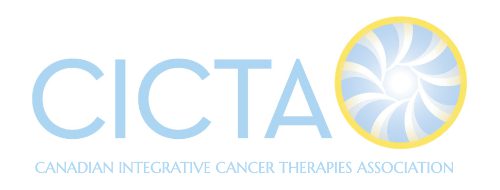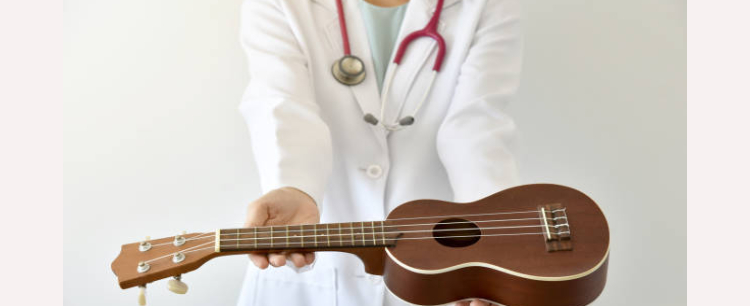Juan Liao, Yufei Yang*, Weiwu Wang, Chunyan Xiang, Quan Guo
Department of Oncology, Xi Yuan Hospital, China Academy of Chinese Medical Sciences, Beijing, China
ABSTRACT
OBJECTIVE To investigate the effect of Traditional Chinese Medicine (TCM) five elements music therapy on improving symptoms for advanced cancer patients.
METHOD A total of 76 patients were enrolled and assigned from December 2005 to May 2007 in the Oncology Department at Xi Yuan Hospital. Meanwhile, two patients were dropped out with death in experimental group, while only one patient dropped out for same reason in control group. The rest of 73 patients were enrolled based on conventional western medicine therapy, 43 patients (59.7%) were treated with listening TCM five elements music therapy in experimental group, while 29 patients (40.3%) were treated without music therapy in control group. The course was 5 days per week for a consecutive four weeks. The outcomes used were self-made subjective symptoms questionnaire, quality of life (QOL), and Karnofsky (KPS) questionnaire. Statistic analysis was performed by SPSS 13.0.
RESULT It was shown that there were statistically significant differences in some symptoms related to lassitude, poor appetite, pain, emotion, insomnia in experimental group, however, no significant differences were found in term of diarrhea, cough, and the total of subjective symptoms.
CONCLUSION No matter what questionnaires were used in two groups, it shown a significantly differences related to improvement of symptoms and QOL when comparing the two groups. TCM five elements music therapy can be a positive benefit with respect to quality of life for advanced cancer patients.
KEYWORDS Traditional Chinese Medicine (TCM); TCM five elements music; quality of life (QOL); advanced cancer
INTRODUCTION
As improvement of society civilization and change of health concept, quality of life (QOL) is more being regarded by people. According to the definition of alleviative treatment by world health organization (WHO), as natural phenomenon, death can be accepted, while life is confirmed. Therefore, improving QOL is being become a very significant objective for patient with cancer [1].
Based on the outcome of depression alleviation by music, we are trying to explore the effect of TCM five elements music therapy on improving cancer patients’ subjective symptoms continuously.
METHODS
General Data
A total of 76 patients were enrolled and assigned from December 2005 to May 2007 in the Oncology Department at Xi Yuan Hospital. Meanwhile, two patients were dropped out with death in experimental group, while only one patient dropped out for same reason in control group. The rest of 73 patients were enrolled based on conventional western medicine therapy, 43 patients (59.7%) were treated with listening TCM five elements music therapy in experimental group, while 29 patients (40.3%) were treated without music therapy in control group. The course was 5 days per week for a consecutive four weeks.
Diagnostic Criteria
Related diagnostic criteria based on TNM classification by American Joint Committee on Cancer (AJCC).
Inclusion Criteria
Patients were histological and cytological confirmed cancer and have ability and willingness to provide written, informed consent as well as are admissible to follow-up and good compliance.
Exclusion criteria
Patients do not meet the above inclusion criteria, having psychiatric disease, intellectual disability, or deafness and Karnofsky score is less than 50 will be excluded from the study.
Treatment Method
Intervention
In experimental group, while conventional chemotherapy regimen applied, patients were treated with TCM five elements music by choosing one of five types of syndrome differentiation accordingly, 30 min each time per day, one cycle for four weeks. The TCM five elements music was composed by a famous musician.
In control group, patients were treated without TCM five elements music, but conventional chemotherapy regimen applied.
Some questionnaires were processed related self-made subjective symptoms, QOL, and KPS with measurement at baseline, the second week and the fourth week respectively.
Observation indices
Objective Index: Quality-of-Life concerns in the End-of–Life Questionnaire (QOLC-E) [2] was used with performance scores from one to five. The higher the score is, the better the QOL for individual patients.
Subjective Index: self-made subjective symptoms questionnaire was made under patient’s feelings; seven items were included related to diarrhea, lassitude, cough, poor appetite, pain, emotion, insomnia respectively. The scale was from 0 to 10, meanwhile, 0 was symptomless, 10 was the most serious illness.
Functional status index: Karnofsky Performance Status (KPS) was monitored. The Karnofsky Performance Scale Index allows patients to be classified as to their functional impairment. This can be used to compare effectiveness of different therapies and to assess the prognosis in individual patients.
Statistical Analysis
All data were processed with SPSS 13.0 software to implement the statistical analysis. Principal component analysis was used for analyzing differential count data by chi-square test, while t-test was used for measurement data.
RESULTS
Principal Component Analysis for Subjective Symptoms
Subjective Symptoms at different stage in two groups
It was shown that there was statistically significant difference in some symptoms related to lassitude, poor appetite, pain, emotion, insomnia in experimental group, however, no significant difference was found in term of diarrhea, cough, and the total of subjective symptoms (Table 1 and Table 2).
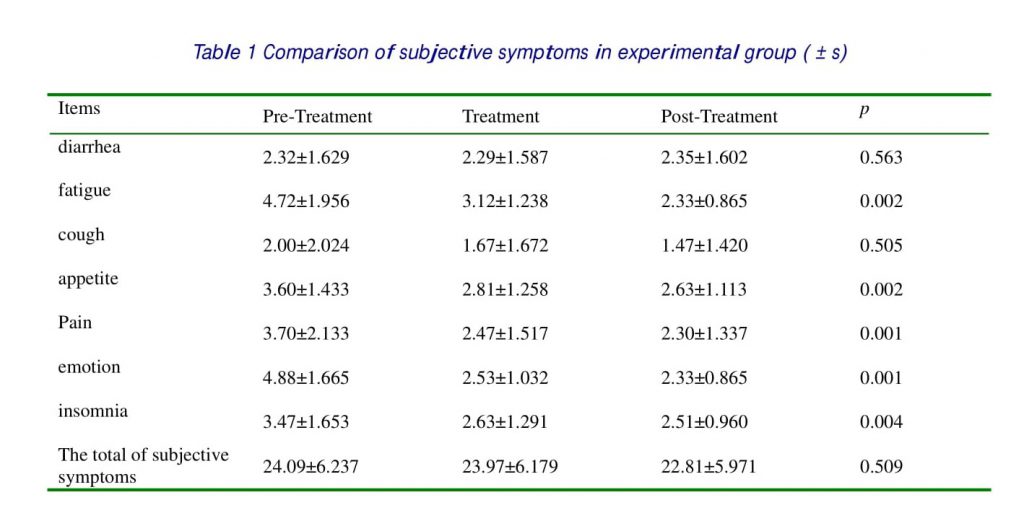
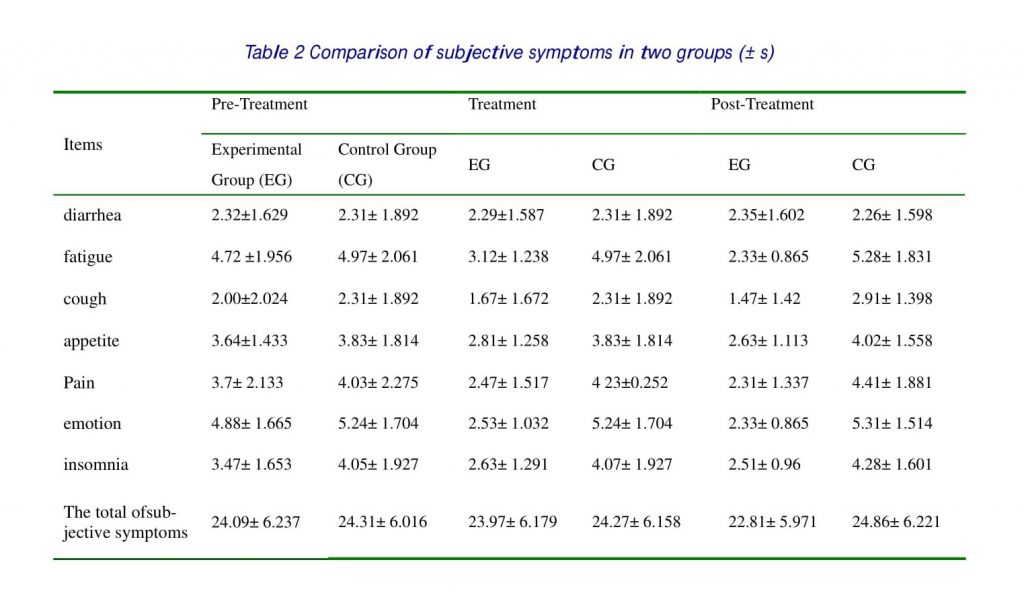
Because of skewness distribution, Mann-Whitney U test was used for it. The results of subjective symptoms before treatment were shown in Table 3. The results indicated that there were no significant differences for subjective symptoms before treatment in two groups by t –test, t=-0.716, p=0.476.
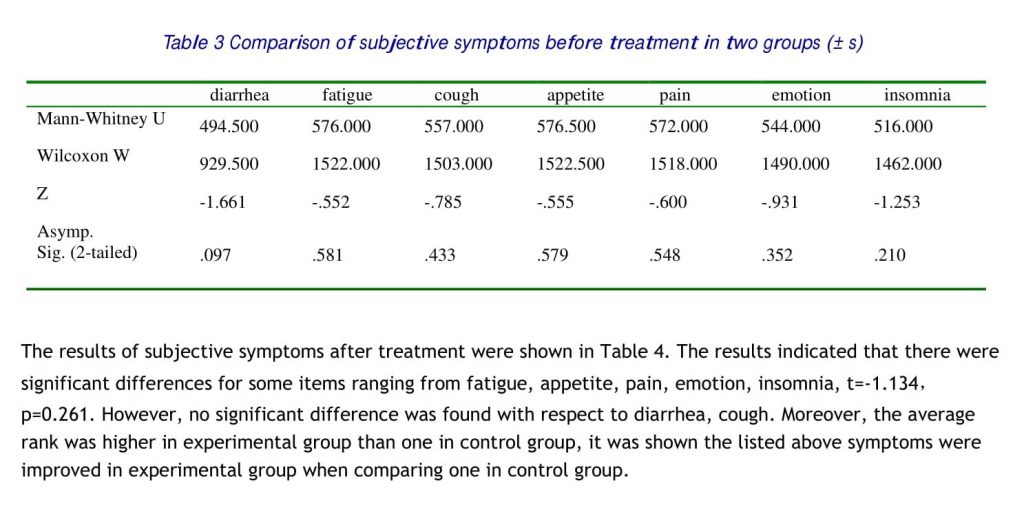

Quality of life (QOL) at different stage in two groups
Because of normal distribution, homoscedasticity variance test was used ranking from QOL to KPS, because data was shown normal distribution, as well as homoscedasticity.
The results indicated that there were no significant differences for items of QOL before treatment, however, only three items were shown significant differences ranking from spirit to sleeping and facial expressions (Table 5). On the contrary, the results indicated that there was a significant difference for some items of QOL related to appetite, spirit, fatigue, pain, self-confidence, daily life, expression, and KPS after treatment, however, no significant differences for some items ranking from sleeping, understanding from colleague, attitude, and the total of QOL (Table 6).
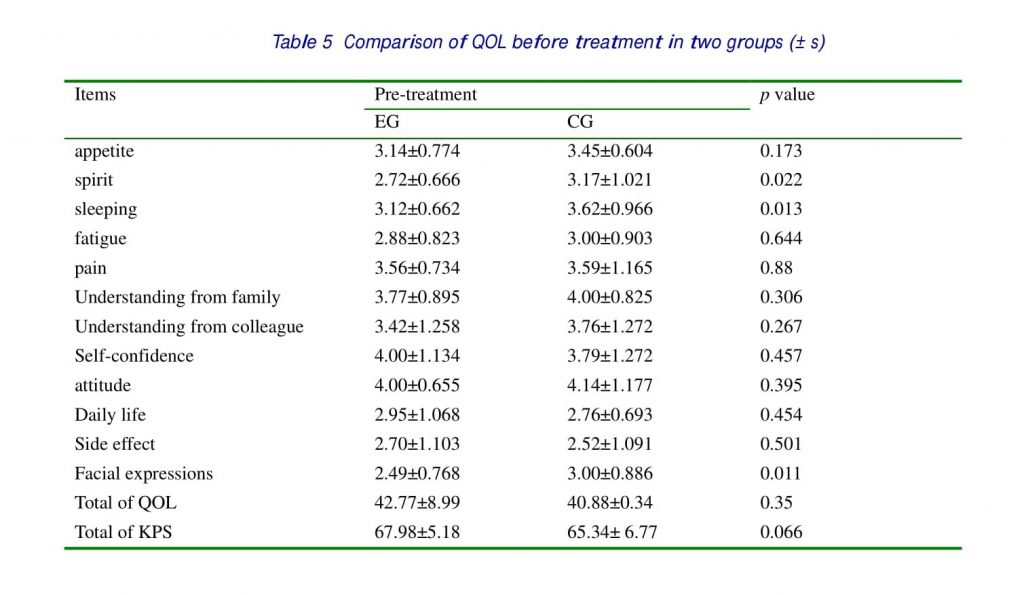
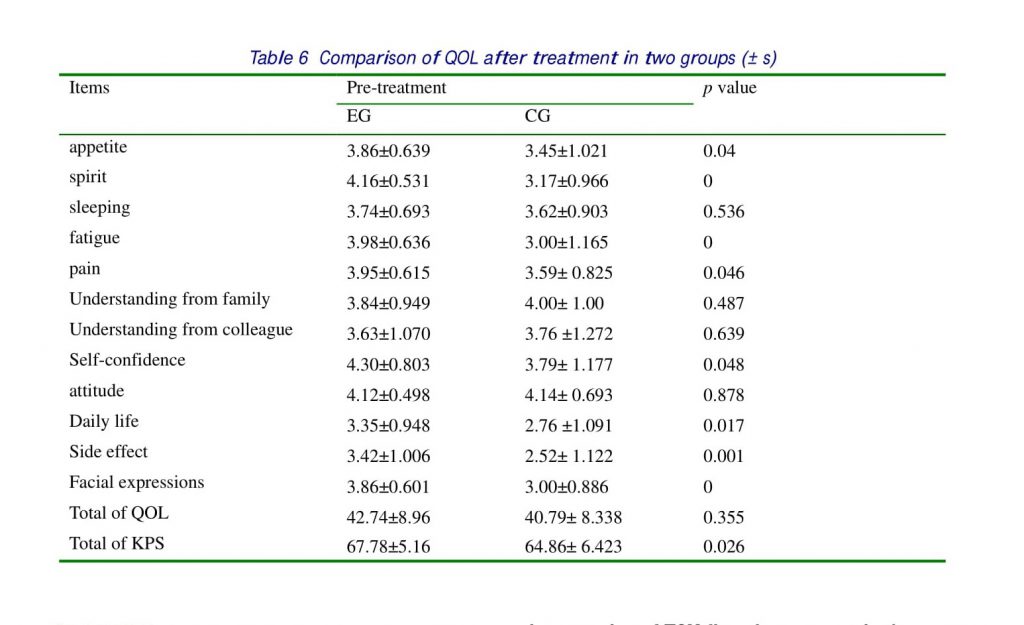
DISCUSSION
As a special therapy, music has a long history in China, and plays an important role for improving quality of life. Two thousand years ago, the therapeutic strategies in Yellow Emperor’s Inner Classic shown there are not only five viscera in human being, corresponding to five tunes of music, but also there are six bowels, corresponding to six rules.
Based on the theories of TCM, TCM five elements music is designed and produced on the basis of the relations between the Wu Xing (five elements related to wood, fire, earth, metal, and water), and Wu Yin (five tunes referred Jue, Zhi, Gong, Shang, and Yu), and aimed to balance yin and yang, regulate qi and blood, maintain operation of one in human body in a state of dynamic homeostatic, keep in good health [4].
Intervention of TCM five elements music therapy for QOL
TCM five elements music could improve some symptoms for cancer patients, the result indicated there were significant differences for some items of subjective symptoms when comparing pre treatment and posttreatment in experimental group, p value was less than 0.05 related to lassitude, poor appetite, pain, emotion, insomnia, however, no significant differences for the total scores of subjective symptoms. It was showed that the music can improve symptoms and the therapy should be observed and analyzed according to therapeutic course, and selected tunes.
Moreover, TCM five elements music has a potential efficacy for health-related quality of life, when comparing two groups, the results indicated that there were significant differences for some items ranging from fatigue, appetite, pain, emotion, insomnia, however, no significant difference was found with respect to diarrhea, cough. Moreover, the average Karnofsky scores were higher in experimental group than that in control group, that means the most of symptoms were improved in experimental group when comparing with control group.
Similarly, the results of QOL indicated that there was a significant difference for some items of QOL related to appetite, mental, fatigue, pain, self-confidence, daily life, expression, and KPS in two groups, however, no significant differences for some items ranking from sleeping, understanding from colleague, attitude, the total of QOL.
Regarding prescription effect of TCM five elements music, as primary factor, it is very important to understand how to select music in clinical practice. It has an impact on patient’s emotion and Zang-fu organs function directly or indirectly based on characteristics of music corresponding with five viscera.
Some research shown there are positive effects to prolong survival rate when some factors such as anxiety and depression are relieved, and active emotion can palliate complicated symptoms associated with chemotherapy such as pain, nausea, and death. Music supportive care may be able to restrain cancer cell growth, improve QOL for cancer patients by improving bad emotion and boosting immune system [4].
Nevertheless, TCM five elements music therapy can be an alternative approach and provide a positive benefit with respect to quality of life for patients with advanced cancer. We are planning a long term follow up for this intervention study, however, more precise design is necessary and will be considered in the future, for example, number of cases, assessment prognosis in pathological confirmed cancer with different stages, assessment the effectiveness of music therapy under randomized controlled trial (RCT), understanding patient’s attitude for music, and culture difference implication etc. We are striving to apply TCM music therapy better in cancer palliative care.
CONCLUSION
No matter what questionnaires were used in two groups, it shown a significantly difference related to improvement of symptoms and QOL when comparing the two groups. TCM five elements music therapy can be a positive benefit with respect to quality of life for advanced cancer patients.
REFERENCE
1 Peng MZ. The research on comparison of quality of life (QOL) for patients between terminal cancer and chronic obstructive pulmonary diseases in advanced stage. China Nursing Journal 2006; 41(3): 202-206.
2 Tao ML Quality-of-Life Assessment in Pediatric Brain Tumor Patients and Survivors: Lessons Learned and Challenges to Face. Journal of Clinical Oncology. 2005; 23(24): 5424-5426.
3 Tao ML Quality-of-Life Assessment in Pediatric Brain Tumor Patients and Survivors: Lessons Learned and Challenges to Face. Journal of Clinical Oncology. 2005; 23(24): 5424-5426.
4 Xiang CY, Guo Q, Liao J etc., The effectiveness of TCM five elements music relieving depression for cancer patients. China Nursing Journal. 2006; 41(11): 969-972.
5 Ying ZM, Liao SH, Lin JD. The efficacy of music therapy with meditation-relaxed therapy to improving quality of life for cancer patient during radiotherapy. China Psychohygiene Journal. 2001; 15(3): 176-178.
6 Burish T.G., Jenkins, R.A., Effectiveness of Biofeedback, and relaxation training in reducing the side effects of cancer chemotherapy. Health Psychol. 1992; 11: 17-23.
Correspondence to:
Prof. Yufei Yang
Department of Oncology, Xiyuan Hospital,
China Academy of Chinese Medical Sciences, Beijing 100091, China
Telephone: +86-10-86683701
Email: yyf93@vip.sina.com
